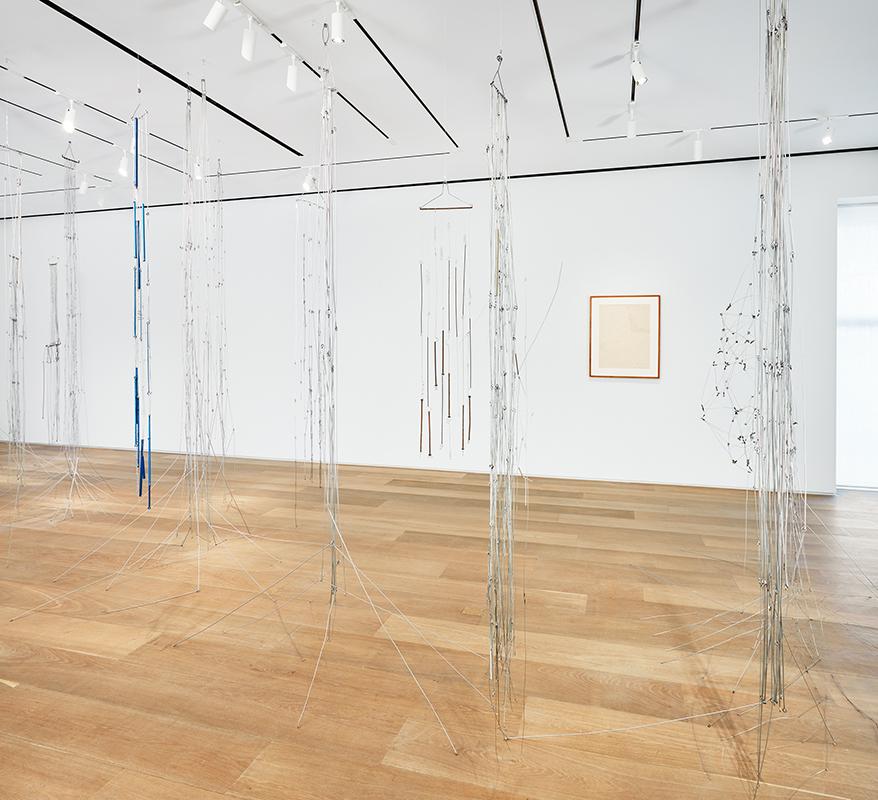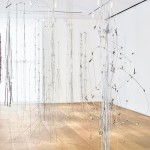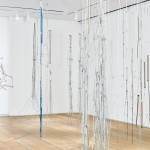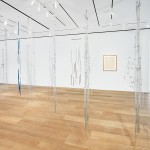Autobiography of a Line has been curated with Sandra Antelo-Suarez and Jesús Fuenmayor.
September 10 – October 24, 2015
Dominique Lévy 909 Madison Avenue New York City
DOMINIQUE LÉVY TO CELEBRATE THE LEGACY OF GEGO WITH EXHIBITIONS AND NEW PUBLICATIONS
New York, NY—Beginning September 10, 2015, Dominique Lévy is pleased to present Gego: Autobiography of a Line, the first in a pair of exhibitions in New York and London celebrating the legacy of German-born Venezuelan artist Gego (Gertrud Goldschmidt [1912 – 1994]). In Gego’s intricate wire sculptures, line becomes a new, three-dimensional language used to describe architectural spaces and engage the bodies within them. Her practice is defined by radical abstraction, giving deeper narrative to forms both graceful and monstrous.
Organized in collaboration with Fundación Gego, Autobiography of a Line brings together key works from the artist’s oeuvre, lent from several institutions including Fundación de Museos Nacionales, Venezuela, Colección Mercantil, Venezuela, Museum of Fine Arts, Houston, and Cisneros Fontanals Art Foundation. The exhibition reunites Gego’s celebrated Chorros for the first time in New York City since their debut at Betty Parsons Gallery in 1971. This group of towering wire sculptures, created between 1970 – 71, embodies the palpable sense of entropic geometry and spatial play for which Gego’s work is internationally admired. Also on view will be late sculptures from the artist’s series of Dibujos sin papel (Drawings without Paper); small- scale Bichitos (Creatures); and works on paper that complicate and question the relationship between drawing and sculpture, such as the Tejeduras (Weavings), as well as other series created throughout the artist’s long career.
Autobiography of a Line will remain on view through October 24th and will be followed in Spring 2016 by a second exhibition devoted to Gego at the gallery’s London space at 22 Old Bond Street in Mayfair. In conjunction with these exhibitions, Dominique Lévy will publish two fully illustrated catalogues examining Gego’s work in a contemporary global context. The first volume will feature texts by curator Chus Martínez, head of the Institute of Art of the FHNW Academy of Arts and Design in Basel, Switzerland and art historian and critic Kaira Cabañas, as well as previously unpublished archival material. The book will also include “GEGO,” a new poem by writer, visual artist, and composer Anne Tardos, exploring the artist’s poetics of the line and performing a linguistic intervention in her work.
Born in Hamburg, Gego emigrated from Germany to Venezuela in 1939 after finishing her training as an architect at the Technischen Hochschule Stuttgart, today the Universität Stuttgart; she was the last of her Jewish family to flee Nazi Germany. Before devoting herself full- time to her artistic practice in 1953, Gego spent several years working as a designer and architect. During this period she taught herself an improvised and intuitive Venezuelan Spanish. In the early sixties she became acquainted with Kinetic Art and Latin American Concretism, which, with its utopian aims, was the predominant movement in Venezuela during her life. Although Gego was encouraged by such artists as Alejandro Otero (1921 – 1990) and Jesús Rafael Soto (1923 – 2005), her work stands apart from both Concretism and arte cinético. Throughout a career spanning four decades, Gego continuously rejected the categorization of her work as part of a particular movement or as comprised of a definitive medium, writing in her notebook, “Sculpture: three dimensional forms of solid material. NEVER what I do!” Like other Jewish-German émigré artists such as Mira Schendel in São Paulo and Eva Hesse in New York, Gego refused to participate in pre-established local artistic discourses. She dedicated herself to an intensive investigation of both the drawn and sculptural line, frequently defying conventions of linear geometry to introduce a quiet but profound sense of formlessness into her work.
In the beginning of her career, Gego worked mainly in watercolor, drawing, printmaking, and handmade books. Among her early books is a slim volume titled
Autobiografía de una Línea (Autobiography of a Line), which contains a collection of the artist’s minimal etchings from 1965. The marks in this tome, from which the exhibition at Dominique Lévy takes its name, seem to either converge or branch away from each other depending on the book’s uncertain orientation. In this way, Autobiografía de una Línea is a precursor to the concerns that Gego would continue to deal with in her later work.
Among works on view in Autobiography of a Line will be the Acuarelas (watercolors) related to the artist’s celebrated Reticulárea series, which she undertook from 1969 to 1982. The sculptural Reticulárea are remarkable for their ever-expanding and collapsing net-like structures that encompass the entirety of their installation space. The related Acuarelas are works on paper Gego created in the early 1980s after briefly abandoning this medium, and enact an exploration of the negative space between the Reticulárea’s interlinking wires. Gego considered the act of line drawing—both on a surface and in space—to be “un trabajo meditativo” (a meditative work), and noted that in these works, “sometimes the in-between-lines are as important as the line by itself.” The concept of “in-between-lines” can be read doubly as an assessment of the negative space between physical lines and as a meditation on the different technical modes of connection at work in her sculpture and drawing. In her Reticulárea, Gego frequently coiled the tips of wires and hooked them together, creating a system in which all points are interconnected. In this way, the Reticulárea are closely related to Gilles Deleuze and Félix Guattari’s concept of the rhizome, an organizational structure which has “no beginning or end; it is always in the middle, between things, interbeing.” Notably, Gego owned a German translation of Deleuze and Guattari’s first published text on the rhizome, published in Mille plateaux (1980).
In 1970, Gego’s sculptural practice shifted as she created the Chorros in a burst of artistic output. Whereas the Reticulárea comprise networks of interconnecting lines, the Chorros are vertical, spatially indeterminate sheaves of wire that cascade to the floor in a torrent, their final form determined by chance as the various rods settle and bend within the spatial confines of their installation. Indeed, although “chorros” is usually translated as “streams,” the title more accurately refers to a waterfall. Gego initially installed the Chorros in her first solo exhibition in New York City at Betty Parsons Gallery in 1971, presenting a chaotic and overwhelming environment of these larger-than-life forms. Autobiography of a Line seeks to reimagine this original installation, bringing together the Chorros that were exhibited at Betty Parsons Gallery. Following the artist’s intention that the Chorros be displayed as a group, the sculptures in Autobiography of a Line occupy and interrupt the space of the viewer, presenting a barrier that requires spectators to literally renegotiate their relationship with movement and architecture.
After the Betty Parsons exhibition in 1971, Gego did not have a solo exhibition in New York again in her lifetime, and her oeuvre remains largely unexamined in relation to the constellation of international artists of the time. She spent the majority of her later years at her studio in Caracas, working on a series of works called Tejeduras (weavings), which will also be on view in Autobiography of a Line. These textile-like creations are works on paper only nominally: the artist treats found scraps of paper as fabric and thread, weaving pages from magazines, metallic strips of cigarette paper, photographs of work, and other elements into a unified whole. Gego had learned to knit as an adolescent in Germany, and it is in this reifying act that the conceptual core of the artist’s practice—with its fervor for creating connections, breaking them apart, tracing wandering lines, and entwining disparate materials and ideas—comes into focus. In presenting a solo exhibition of Gego’s work in New York, Autobiography of a Line seeks to strengthen the artist’s position in an international context and highlight the ways in which her work remains imminent—in a Deleuzian perpetual process of becoming—today.
About the Artist
Gego (Gertrud Goldschmidt) was born on August 1, 1912, to a liberal Jewish banking family in Hamburg, Germany. She studied under Paul Bonatz at the Technische Hochschule Stuttgart, today Universität Stuttgart, where she graduated with an architecture and engineering degree in 1938. She was forced to emigrate from Germany shortly after finishing her degree and moved to Venezuela in 1939. There she worked as an architect and operated her own furniture workshop. She became a Venezuelan citizen in 1952 and lived there for the remainder of her life.
In 1953, Gego began to develop her artistic practice full-time with the support and guidance of her life partner, Gerd Leufert, who was also an artist and graphic designer. Encouraged by the support of Alejandro Otero and Jesús Rafael Soto, Gego began to create three-dimensional works in 1956. During these three years, she operated in the margins of the Venezuelan kinetic and op art movements, and continued to research mathematics, architecture, and philosophy. In 1957 Gego participated in the exhibition Arte abstracto en Venezuela and by 1959 the Museum of Modern Art in New York had begun acquiring her work. She lived in New York briefly in 1960 and made several extended visits to the United States until 1967. In New York, she attended the Pratt Institute, where she took engraving and printmaking classes. She also worked in the Tamarind Lithography Workshop in Los Angeles before returning to Venezuela in 1967. For most of her career, she worked at a home studio in Caracas, creating a prolific and varied oeuvre consisting of sculptures and works on paper. She died in Caracas on September 17, 1994.
Recent solo exhibitions of Gego’s work include Gego. Obra Completa. 1955 – 1980, Museo de Bellas Artes, Caracas (2001); Questioning the Line: Gego, a Selection, 1955 – 1990, Museum of Fine Arts, Houston, Museo de Arte Conempoáneo de Monterrey, and Museo Rufino Tamayo, Mexico City (2002); Gego: Between Transparency and the Invisible, The Museum of Fine Arts, Houston (2005), Museo de Arte Latinamericano de Buenos Aires, Biblioteca Luis Angel Arango, Bogotá (2006), and The Drawing Center, New York (2007); Gego: Defying Structures, Museu de Arte Contemporánea de Serralves, Porto, and Museu d’Art Contemporani de Barcelona, Spain (2006); Gego. Procedencia y Encuentro., Sala Mendoza, Caracas, and Americas Society, New York, (2012); Gego: Line as Object, Hamburger Kunsthalle, Kunstmuseum Stuttgart, and Henry Moore Institute, Leeds (2013 – 2014); and Gego. Poetique de la Ligne. Colección Mercantil, Maison de l’Amérique Latine, Paris (2014); and A iminência das poéticas, 30th Sao Paulo Biennial. Her work is in the collections of, among others, The Museum of Modern Art, New York; The Museum of Fine Arts, Houston; Fundación Museos Nacionales, Venezuela; New York Public Library, New York; Tate Modern, London; and the Art Institute of Chicago.
For additional information please contact
Andrea Schwan, Andrea Schwan Inc. info@andreaschwan.com, +1 917 371 5023
Full Copyright and Courtesy Credits
Installation view of Chorros at Betty Parsons Gallery, New York, 1971. Photo: Ana María Castillo
© Fundación Gego
GEGO (Gertrud Goldschmidt) was born on August 1, 1912, to a liberal Jewish banking family in Hamburg, Germany. She studied under Paul Bonatz at the Technische Hochschule Stuttgart, today Universität Stuttgart, where she graduated with an architecture and engineering degree in 1938. She was forced to emigrate from Germany shortly after finishing her degree and moved to Venezuela in 1939. There she worked as an architect and operated her own furniture workshop. She became a Venezuelan citizen in 1952 and lived there for the remainder of her life.
In 1953, Gego began to develop her artistic practice full-time with the support and guidance of her life partner, Gerd Leufert, who was also an artist and graphic designer. Encouraged by the support of Alejandro Otero and Jesús Rafael Soto, Gego began to create three-dimensional works in 1956. During these three years, she operated in the margins of the Venezuelan kinetic and op art movements, and continued to research mathematics, architecture, and philosophy. In 1957 Gego participated in the exhibition Arte abstracto en Venezuela and by 1959 the Museum of Modern Art in New York had begun acquiring her work. She lived in New York briefly in 1960 and made several extended visits to the United States until 1967. In New York, she attended the Pratt Institute, where she took engraving and printmaking classes. She also worked in the Tamarind Lithography Workshop in Los Angeles before returning to Venezuela in 1967. For most of her career, she worked at a home studio in Caracas, creating a prolific and varied oeuvre consisting of sculptures and works on paper. She died in Caracas on September 17, 1994.
Recent solo exhibitions of Gego’s work include Gego. Obra Completa. 1955 – 1980, Museo de Bellas Artes, Caracas (2001); Questioning the Line: Gego, a Selection, 1955 – 1990, Museum of Fine Arts, Houston, Museo de Arte Conempoáneo de Monterrey, and Museo Rufino Tamayo, Mexico City (2002); Gego: Between Transparency and the Invisible, The Museum of Fine Arts, Houston (2005), Museo de Arte Latinamericano de Buenos Aires, Biblioteca Luis Angel Arango, Bogotá (2006), and The Drawing Center, New York (2007); Gego: Defying Structures, Museu de Arte Contemporánea de Serralves, Porto, and Museu d’Art Contemporani de Barcelona, Spain (2006); Gego. Procedencia y Encuentro., Sala Mendoza, Caracas, and Americas Society, New York, (2012); Gego: Line as Object, Hamburger Kunsthalle, Kunstmuseum Stuttgart, and Henry Moore Institute, Leeds (2013 – 2014); and Gego. Poetique de la Ligne. Colección Mercantil, Maison de l’Amérique Latine, Paris (2014); and A iminência das poéticas, 30th Sao Paulo Biennial. Her work is in the collections of, among others, The Museum of
Modern Art, New York; The Museum of Fine Arts, Houston; Fundación Museos Nacionales, Venezuela; New York Public Library, New York; Tate Modern, London; and the Art Institute of Chicago.
NEW YORKER
Art: Galleries Uptown
Gego
https://www.newyorker.com/goings-on-about-town/art/gego-3
HUFFPOST
Reprising Postminimalism in 4 New York Shows: Gego, Nasreen Mohamedi, Ruth Hardinger and Kara Rooney
By G. Roger Denson
04.04.2016
https://www.huffpost.com/entry/reprising-postminimalism_b_9609526
descubrir el ARTE
Gego, complejas líneas que tejen la vida
10.20.2015
https://www.descubrirelarte.es/2015/10/20/gego-complejas-lineas-que-tejen-la-vida.html
BLOOMBERG
Art: The 10 Gallery Shows You Need to Pay Attention to This Fall
Surprise! None of them include colorful, abstract paintings.
By James Tarmy
09.11.2015
https://www.bloomberg.com/news/articles/2015-09-11/the-10-gallery-shows-you-need-to-pay-attention-to-this-fall
HYPERALLERGIC
Connecting the Lines Between Gego and Sarah Sze
By Elisa Wouk Almino
https://hyperallergic.com/244294/connecting-the-lines-between-gego-and-sarah-sze/
FORWARD
Gego Draws a Line at the Holocaust
By Yevgeniya Traps
10.10.2015
https://forward.com/culture/art/322214/messages-from-the-holocaust-at-the-dominique-levy-gallery/
ARCHITECTURAL DIGEST (AD)
CULTURE + LIFESTYLE – Art Shows Opening Soon in New York
Preview the New York art shows you need to see
By Alexa Lawrence
05.02.2014
https://www.architecturaldigest.com/gallery/new-york-art-shows-coming-soon-slideshow
September 10 – October 24, 2015
Gego: Autobiography of a Line was the first in a pair of exhibitions in New York and London celebrating the legacy of German-born Venezuelan artist Gego (Gertrude Goldschmidt [1912 – 1994]). In Gego’s intricate wire sculpture, line becomes a newly dimensional language with which to describe architectural space and engage the human body. Her practice is defined by radical abstraction, giving deeper narrative to forms both graceful and monstrous. © 2015 Dominique Lévy Gallery Producer: Dion Tan








